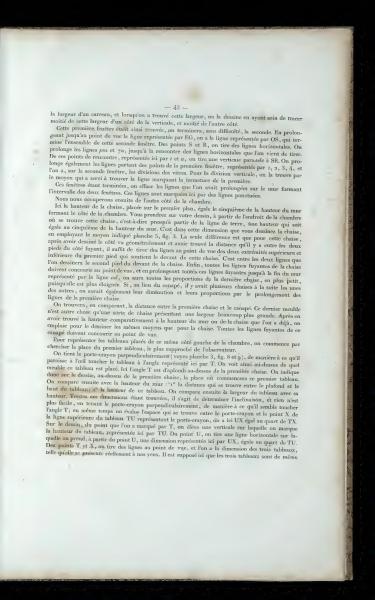The width of a tile, and when this width is found, it is drawn with care to divide this width into half on one side of the vertical, and half on the other side. Once this first window is found, the second one is completed without difficulty. By extending up to the vanishing point the line represented by EG, or the line represented by OS, which completes the entirety of this second window. From points S and R, horizontal lines are drawn. The lines pm and 7m are extended until they meet the horizontal lines just drawn. From these intersection points, represented here by t and u, a vertical parallel to SR is drawn. The lines starting from the points of the first window, represented by 1, 2, 3, 4, are also extended, and on the second window, the divisions of the panes are completed. The vertical division is found using the method that helped find the line marking the closure of the first one. Once these windows are complete, the lines that were extended over the wall forming the interval between the two windows are erased. These lines are marked here by dotted lines. We will then focus on the other side of the room. Here the height of the chair, placed on the foreground, is equal to one-fifth the height of the wall forming the side of the room. On your drawing, from the place in the room where the chair is located, that is, almost starting from the ground line, take a height equal to one-fifth of the height of the wall. You will draw the chair using this dimension, utilizing the method indicated in plate 5, fig. 3. The only difference is that for this chair, after measuring the side which is generally found by the spacing between the two feet on the fixing side, it suffices to draw lines to the vanishing point from the two extreme points, upper and lower, of the front foot supporting this chair. It is between these two lines that the second front foot of the chair is drawn. Finally, all the receding lines of the chair converge at the vanishing point, and by extending all these receding lines to the end of the page, represented by line ad, the proportions of the last chair, although smaller because it is further away, are maintained. If instead of the sofa, there were several chairs in sequence, one would also have their diminution and proportions by extending the lines from the first chair.
Comparing, one can find the distance between the first chair and the sofa. This latter piece of furniture is nothing more than a sort of chair presenting a much wider width. After finding its height in comparison to the height of the wall or chair established, the same methods used for the chair can be employed to draw it. All the receding lines of this sofa should converge at the vanishing point.
To represent the paintings placed on this same left side of the room, start by determining the position of the first painting, the one closest to the observer. Hold the pencil upright (see plate 3, fig. 8 and 9), so it seems to touch this painting and the angle represented here by T. Thus, it becomes clear above which piece of furniture this painting is placed. Here the angle T is vertically above the first chair. Therefore, above the first chair's top, indicate where this first painting will begin. Then compare with the height of the wall: "I'” the distance which is between the ceiling and the top of the painting; the width of this painting. The width of the painting is subsequently compared to its height. Once all these dimensions are found, the inclination is determined, and nothing is easier; by holding the pencil upright, so it seems to touch angle T; at the same time evaluate the space between the pencil and point X on the upper line of the painting. TU representing the pencil, UX here equals a quarter of TX. On the drawing, from the point marked by T, a vertical is raised on which the height of the painting is marked, represented here by TU. From point U, draw a horizontal line on which a dimension is taken, from U, represented here by UX, equal to a quarter of TU. From points T, G, and X, lines are drawn to the vanishing point, and the dimension of the three paintings as they actually appear to our eyes is achieved. It is assumed here that the three paintings are of the same
- 43 -
Translation Notes:
The terms "vanishing point," "receding lines," and "pencil" are related to perspective drawing. The “ground line” refers to the level on which the objects are resting in perspective drawings. The reference to “furniture” and “painting” suggests an instructional theme on how to proportion objects accurately using perspective.
The text provides detailed instructions on drawing techniques, particularly focusing on using perspective to proportion objects accurately. It describes methods to determine views and drawing intersecting lines to create windows, furniture, and paintings. The described method emphasizes the use of a vanishing point and receding lines for precise rendering in perspective drawing.
